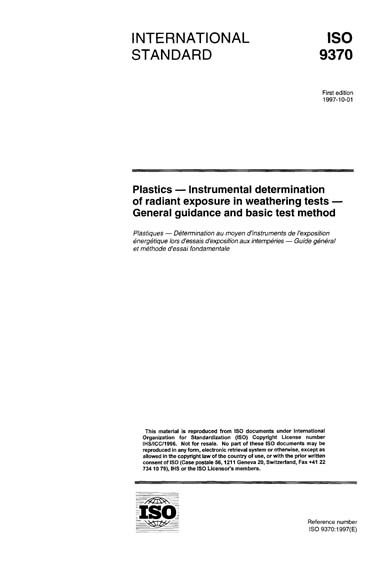Historical
ISO 9370:1997
Plastics - Instrumental determination of radiant exposure in weathering tests - General guidance and basic test method
This International Standard specifies methods for the instrumental measurement of irradiance on a planar surface. This includes both natural and simulated natural exposure testing.
Instrumental techniques include the continuous measurement of total solar and spectral solar irradiance (with emphasis on the ultraviolet wavelength region), and the accumulation (or integration) of instantaneous data to provide a total radiant exposure (dosage).
Exposure in apparatus using artificial light sources sometimes requires measurement of irradiance and radiant exposure at specified wavelengths in order to monitor and, if required, control the irradiance on a planar surface and/or to define quantitatively the exposure stages of an exposed specimen. Typically, measurements of radiation in the 290 nm to 400 nm band, or narrow-band measurements with centre wavelengths at, for example, 340 nm or 420 nm, are required. However, in contrast to natural exposure conditions, radiation of wavelengths shorter than 300 nm is present in most light sources used in laboratory accelerated tests, and is known to cause rapid degradation in many polymers. In addition, radiation of longer wavelengths can be very important in product degradation such as colour fade. Therefore, it may be very useful to monitor short-wavelength radiation of less than 300 nm and long-wavelength radiation at wavelengths greater than 400 nm.
This International Standard dees not specify procedures using blue wool standards, chemical actinometry, monochromators or polymeric and other film dosimetry.
The total solar and solar ultraviolet radiation measuring instruments described in this International Standard can be used in the following exposure tests:
- Natural exposure tests Measurement of total solar and solar ultraviolet radiation using the instruments and procedures specified in this International Standard will improve the comparability of exposure tests conducted at different times in a single location. It may also improve the comparability of results obtained in different locations with similar climates. However, comparison of results from exposures in different locations must also consider the effects of temperature, moisture and other climatic factors on the type and rate of product degradation as well as the level of solar radiation.
- Comparison between natural exposure and laboratory accelerated tests Measurements of ultraviolet and/or visible radiation using the instruments and procedures specified in this International Standard may aid in comparing results from artificial accelerated tests with those from natural exposure. When this is done, comparison should be made in several passbands. Comparing the radiation in a short-wavelength UV passband is necessary to gauge the relative severity of the exposure and to estimate the risk that the accelerated test might produce degradation reactions that would not occur in a natural exposure. The intensity and spectral distribution of the radiation used in accelerated tests is only one factor in determining the comparability of results obtained in natural exposures. One must also consider temperature, moisture and other climatic factors (notably pollution effects) when making these comparisons. Because of differences between a material's response to increased radiation levels and possible differences in temperature and/or moisture, and the possibility of pollution effects in natural exposure tests, “acceleration factors” relating time in an accelerated test to time in a natural exposure based on comparison of radiation intensities should never be used.
- Accelerated exposure tests with laboratory light sources Measurements of ultraviolet and visible radiation using the instruments and procedures described in this International Standard may aid in improving the reproducibility of accelerated tests using laboratory light sources. However, monitoring irradiance in a single passband is usually not sufficient to detect all differences caused by variation in filter type or solarization of filters. Generally, it is best to monitor radiation in both a short-wavelength passband as well as a long-wavelength passband to detect changes in radiation due to filter variation. This is essential to ensure improved reproducibility between laboratory accelerated exposure tests.
International Organization for Standardization [iso]

